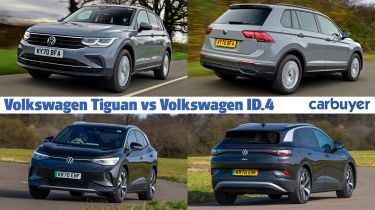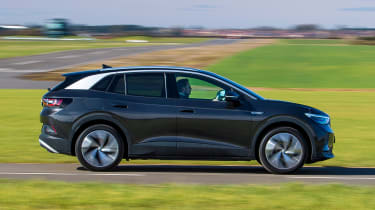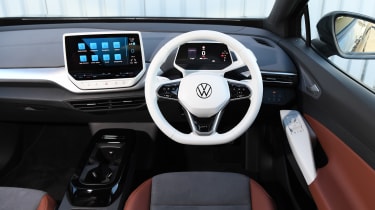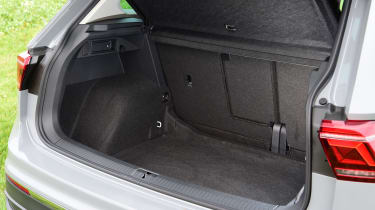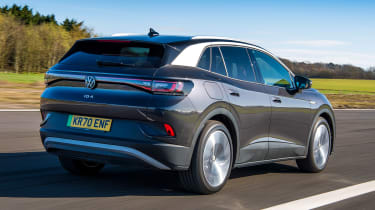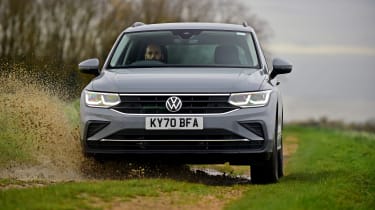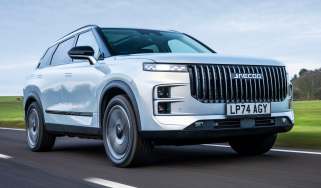Volkswagen Tiguan vs Volkswagen ID.4: rivals comparison
The VW Tiguan and ID.4 are two similarly sized SUVs, but one has conventional engines and one’s electric. Which should you buy?
Few, if any, car companies sell as many types of SUVs as Volkswagen. You’re catered for whether you want to spend £20,000 or £80,000, and there’s a choice of petrol, diesel, plug-in hybrid or fully electric models. One of the best-selling is the mid-size Volkswagen Tiguan, and consequently that makes the new pure-electric Volkswagen ID.4 very important to the company.
Why? Because the ID.4 has helped to launch VW’s ‘ID.’ electric sub-brand, and lots of buyers are moving away from hatchbacks and saloons towards SUVs of this size. To make the ID.4 appeal to customers, it has smart styling, a decent range, a high level of standard equipment and a practical interior.
The Tiguan is mechanically similar to the SEAT Ateca and Skoda Karoq, while other rivals include the Peugeot 3008, Ford Kuga, Hyundai Tucson, Mazda CX-5 and Kia Sportage. The ID.4 shares its underpinnings with the Skoda Enyaq and Audi Q4 e-tron, rivalling electric SUVs like the Kia e-Niro, Ford Mustang Mach-E and the upcoming Nissan Ariya.
Styling
The Tiguan is based on the Volkswagen Golf, with the recently facelifted Tiguan getting a redesign similar to the latest Mk8 Golf. High-spec models get chrome trim and fancy-looking headlights, but the Tiguan has always been conservatively styled compared to some rivals. There’s no imaginatively styled window line and only simple body creases, but there’s no denying it looks smart.
As the ID.4 is VW’s next-generation SUV and a brand-new product, its designers have added a few extra styling flourishes - including the coloured rearmost C-pillar to make the roof look like it’s floating. Unsurprisingly, it shares parts with the Volkswagen ID.3 hatchback, and borrows many of the same modern styling details. A blanked-out grille highlights its zero-emission powertrain.
Interior
Climb into the Tiguan and the interior feels smart, but it’s hardly the last word in modern design. It just feels a little plain with an ordinary design, although everything is right where you’d expect it to be and is easy to use as a result. Build quality is very good, too, and the quality of materials reminds you why the Tiguan costs more than a Karoq or Ateca. High-spec cars get a smart looking digital instrument cluster.
That comes as standard in the ID.4, which has a much more minimalistic and modern look inside. The digital dials and touchscreen both sit on top of the dashboard, and more space is freed up by having the gear selector mounted behind the steering wheel. However, it’s not all straightforward; several functions are buried too deep in the infotainment system, the lack of physical buttons make it hard to use on the move, and the quality of the materials doesn’t quite match the price tag.
Practicality
It’s common for a car to increase in size between one generation and the next, and the Tiguan is larger than its predecessor. Luggage and passenger space have both improved, and the rear seats can slide forwards and backwards so you can prioritise one or the other. Slide the seats forward and you have a huge 615-litre boot, up from a still-generous 520 litres with the seats slid back. There’s also a variable boot floor. If that’s not enough space, there’s a seven-seat Volkswagen Tiguan Allspace version. Meanwhile, the Tiguan trumps the ID.4 for towing capacity - with the Tiguan officially capable of hauling up to 2,500kg, versus 750kg for the ID.4.
Measuring 75mm longer than the Tiguan, the ID.4 immediately has a space advantage. Its interior dimensions are further improved by the electric powertrain’s smaller packaging, and there’s no transmission tunnel. That means the rear seats are very spacious, and even someone in the middle seat has a flat floor and plenty of legroom. It’s one of the roomiest mainstream electric SUVs on sale. Its 543-litre boot is an excellent size, and there’s a dedicated cubby for the charging cable under the boot floor. That’s handy until you need to charge when you’ve got a boot full of stuff, so it’s disappointing that Volkswagen hasn’t included a storage area under the bonnet like you’d find in rivals.
Economy
The Tiguan has several different engines to choose from, and the 148bhp petrol and diesel engines are reasonably economical, managing up to 44mpg and 53mpg respectively. Choose the more powerful diesel or four-wheel drive and 42mpg is about as much as you can hope for. The 2.0-litre petrol engines are thirsty, returning MPG in the low 30s. With the facelift, VW introduced a plug-in hybrid powertrain that offers up to 31 miles of pure-electric range and claimed triple-digit fuel economy figures. It’s expensive for private buyers, but offers a very low Benefit-in-Kind (BiK) rate for company-car drivers.
 Top 10 best electric SUVs – the ones to buy in 2025
Top 10 best electric SUVs – the ones to buy in 2025
Efficiency is measured a little differently in electric cars, with a greater focus on the maximum range you can travel. The ID.4 can be specced with two battery sizes, with up to 213 miles from the smaller 52kWh battery and a maximum 322-mile range from the 77kWh option. Charging from zero to 80% takes just over half an hour from a 110kW public charger, or you can fully recharge from a home wallbox in seven and a half hours. If you can regularly charge at home, your running costs will be much lower than a petrol or diesel car as a full charge typically costs just a few pounds. VED (road tax) is free and servicing may work out cheaper, while business users can look forward to a very low BiK rate.
Performance
Even the lowest-powered Tiguan offers reasonable acceleration, as the 148bhp petrol takes nine seconds to sprint from 0-62mph. The Tiguan now offers the same engines you’ll find in the Golf GTI and Golf R, so can reach 62mph in just six and five seconds respectively. The Tiguan is comfortable and smooth (R-Line versions are a bit firmer), with minimal body lean in fast corners.
The cheapest ID.4 also comes with 148bhp, but its extra weight means 0-62mph takes nearly 11 seconds. Versions with 168 and 201bhp are also available, reducing the sprint down to nine and 8.5 seconds. Top speed for all three is 99mph. It might come as a surprise that the ID.4 is very good to drive and, with all the heavy batteries placed very low, it doesn’t lean as much as you’d expect. There’s also a faster ID.4 GTX version, which is even more agile and offers very punchy acceleration.
Prices and specifications
A model called Life kicks off the Tiguan range, featuring Apple CarPlay, Android Auto, LED headlights and alloy wheels for around £25,500. Life trim, costing from around £28,500, also features multi-zone air conditioning, parking sensors and sat nav, and Active adds ambient lighting and heated seats for £500. Above that is the luxurious Elegance and the sporty R-Line for approximately £34,500, plus the standalone Tiguan R for £47,200.
The ID.4 range starts with Life trim. With prices starting at £35,000 it looks expensive, and as of December 2021 the car is no longer eligible for a government grant. As mentioned above, the ID.4 also brings cheaper running costs, and the standard equipment includes two-zone air con and heated seats. The next trim, Style, costs considerably more at around £38,700. That’s offset by an equipment list that includes a reversing camera, keyless entry and upgraded Matrix LED headlights. Family trim gives you the bigger battery and a panoramic sunroof for a little over £46,000, and the fully kitted out Max trim costs £51,500.
 Volkswagen ID.4 vs Ford Mustang Mach-E - rivals comparison
Volkswagen ID.4 vs Ford Mustang Mach-E - rivals comparison
The difference isn’t vast on a PCP finance deal, however. We’ve configured a Tiguan Life with the 148bhp petrol engine and a DSG automatic gearbox (£30,200) against the similarly powered ID.4 Life for a fair comparison. At the time of writing, a four-year, 10,000-mile-a-year deal requires a monthly payment of around £355 for the Tiguan after a £3,020 deposit, versus £390 per month for the ID.4 after a £3,215 deposit. Look out for ID. events at your local dealer, which could give you a sweeter deal than the VW prices we’ve listed here.
Verdict
The Tiguan is a very good family SUV, with a practical and clearly laid out interior. It also benefits from smart looks and a decent blend of performance and economy, plus a larger towing capacity than the ID.4. But we think the Tiguan looks rather plain against the newer ID.4, which adds a dash of extra style inside and out. Rear-seat passengers will enjoy the extra legroom in the ID.4 as well, and that the price of the entry-level Life trim is comparable to a Tiguan should sway plenty of buyers as well.
Of course, the electric powertrain and infrastructure won’t suit everyone’s lifestyle but, if you can charge at home regularly, we recommend the ID.4 over the Tiguan.
Are you looking at other low-emission cars? Check out our guides to the best hybrid SUVs, best plug-in hybrids and the best electric cars.
Recommended

New Subaru Trailseeker revealed as rugged electric SUV with 375bhp

New Subaru Solterra brings more range, power and polish
Most Popular
Tips & advice

Car dashboard warning lights: what does each symbol mean?

Electric car charging stations: public networks, charger types, apps and maps


